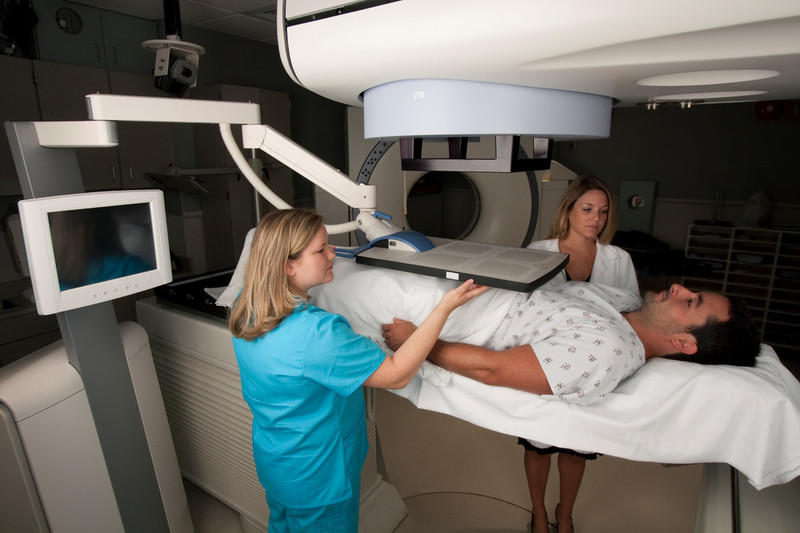New risk algorithm could improve screening for prostate cancer
Published: 10 March 2022
 Man receiving radiotherapy treatment for prostate cancer.
Man receiving radiotherapy treatment for prostate cancer.
Calculating a person’s risk of developing prostate cancer using results from two blood markers would improve the accuracy of screening for the disease, reports a new study led by St George’s, University of London affiliated researchers, alongside UCL and Queen Mary University of London.
Prostate cancer is the most common form of cancer in men, with more than 10,000 men dying from the disease every year in the UK, but there is currently no national screening programme.
That is partly because the current best first-line test - a blood test that detects raised levels of the prostate-specific antigen (PSA) - is not wholly reliable, missing some harmful cancers as well as giving false positives. False positives include not just false alarms where there is no cancer but the discovery of harmless cancers that are unnecessarily treated.
In a new study, published in the Journal of Medical Screening, researchers developed an algorithm estimating a person’s risk of developing prostate cancer based on age and the levels of two prostate cancer markers, PSA and hK2 (human kallikrein peptidase).
They tested how well the algorithm could predict prostate cancer by comparing blood samples of men who later died after a prostate cancer diagnosis with those who were never diagnosed with the disease.
They found that, by setting a risk threshold above which men are counted as “screen positive”, the approach would reduce the number of false positives by three quarters compared to a standard PSA test, while catching the same proportion of cancers.
Lead author, Professor Sir Nicholas Wald from the UCL Institute of Health Informatics and Population Health Research Institute at St George’s, said: “A key drawback of screening for prostate cancer using a PSA test alone is the higher risk of a false positive, which can lead to an unnecessary, invasive biopsy and the unnecessary treatment of a clinically insignificant cancer that would not have caused harm anyway.
“Our study shows a different screening approach could reduce the number of false positives by three quarters. This would make screening for prostate cancer safer and more accurate, reducing overdiagnosis and overtreatment.
“The next step is to test the feasibility of this approach in practice with a pilot project inviting healthy men for screening. If the project is successful, we believe this approach ought to be considered as part of a national screening programme for all men.”
Co-author Professor Joan Morris, also from the Population Health Research Institute at St George’s, added: “We know from autopsy evidence that many men die with prostate cancer, but without it causing their death, which is why it’s important to be careful about avoiding overdiagnosis of prostate cancers.
“The approach in our paper includes an additional prostate cancer marker, reducing the rate of false positives, which could improve our ability to screen for prostate cancers. Further testing will confirm if the benefits of a screening programme could outweigh any disadvantages.”
For the study, the researchers looked at data and blood samples from more than 21,000 men recruited into the prospective BUPA study over 40 years ago.
They analysed a number of prostate cancer markers in blood samples of 571 men who later died from or with prostate cancer, comparing these with a control group of 2,169 men who were never diagnosed with the disease.
They noted that while hK2 was a relatively weak marker for prostate cancer on its own, it was relatively independent of PSA so the two together yielded a more accurate test.
They categorised the results of the total PSA and hK2 tests based on how far away from average they were according to the participant’s age. They also included age into their assessment of risk.
All men who were estimated to have a one in 20 or greater risk of developing prostate cancer in the next five years were counted as “screen positive”.
The researchers found that if men aged 55 and over were screened at least five yearly using this risk cut-off, 90% of cancer cases would be detected, with only 1.2% of cases being false positives.
If a PSA test had been used to screen for the disease on its own, in one scenario modelled by the researchers, an 86% detection rate would have been accompanied by a false positive rate of 2%. By comparison, if the risk-based approach had been adjusted to have a detection rate of 86%, the false positive rate would have been 0.5% - a reduction of three quarters.
Professor Roger Kirby, President of the Royal Society of Medicine and Vice-President of Prostate Cancer UK, who was not involved in the study, said: “This is a novel approach which utilises the levels of two prostate cancer markers, PSA and hK2 (human kallikrein peptidase) to refine prostate cancer screening. The use of PSA alone has significant drawbacks in terms of screening, but the addition of the hK2 marker in this context carries the genuine promise of significantly reducing the death rate from this most common cancer in men.”
St George's recently announced a new partnership with NeoPhore, a cancer immuno-oncology company that is seeking to develop therapies that make cancers more easily recognised for destruction by the immune system. You can read more about the partnership in our news story.